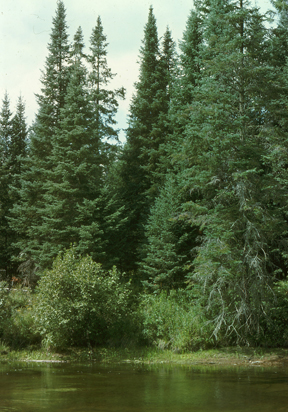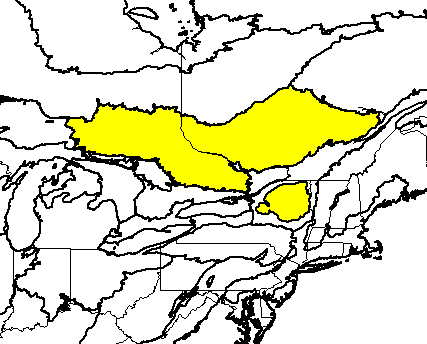
Algonquin National Park, Ontario (c) 2004 Maurice J. Kaufmann
Bioimages home (click on an image to enlarge)
view
this page in its intended navigation context
Eastern Forest/Boreal Transition
(WWF
ecoregion
NA0406)

Algonquin National Park, Ontario
(c) 2004 Maurice J. Kaufmann

Source of bioregions data:
Olson, D. M. and
E. Dinerstein. The Global 200: Priority ecoregions for global conservation. (PDF
file) Annals of the Missouri Botanical Garden 89:125-126.
Distinctiveness (1=highest,4=lowest): 4
(nationally important)
Forests in this ecoregion are a mixture of deciduous and coniferous species.
This is the southern limit of timber wolves in eastern North America. The
most widespread old-growth red and white pine stands remain here.*
Conservation Status (1=most endangered, 5=most
intact): 3 (vulnerable)
10% of the ecoregion remains as intact habitat. It is highly fragmented by
forestry settlements, ski facilities and agriculture.*
 Picea glauca (white spruce)
Picea glauca (white spruce) Populus
tremuloides (quaking aspen)
Populus
tremuloides (quaking aspen)
 Pinus resinosa
Pinus resinosa Pinus
strobus
Pinus
strobus Acer
saccharum
Acer
saccharum Tsuga
canadensis
Tsuga
canadensis Fagus
grandifolia
Fagus
grandifolia Picea mariana
Picea mariana Acer
rubrum
Acer
rubrumSome views from the ecoregion
Lake Superior Provincial Park, Ontario

(c)
2005 Scott and
Ruth Bassett
hires
* Ricketts, T.H., E. Dinerstein, D.M. Olson, C.J. Loucks, et al. (1999) Terrestrial Ecoregions of North America: A Conservation Assessment. World Wildlife Fund - United States and Canada. Island Press, Washington, D.C. pp. 160-162.
Except as noted, images copyright 2002-2005 Steve Baskauf - Terms of use